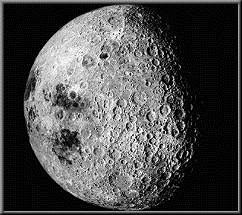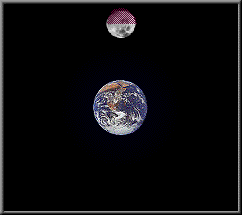www.moonlandings.co.uk
Moon Gravity | Far Side | Static Moon | Earth Facts | Top Ten Scientific Discoveries | Spinoffs | Landing Sites | The Future for the Moon | Water on the Moon? | Detailed Moon Statistics
Far Side
Until the twentieth century the Moon held a great secret from observers on Earth. On Earth, only one side of the Moon is ever visible. The side of the Moon that cannot be seen from Earth is called the 'far side'. Until the start of human exploration of the Moon, the far side of the Moon was shrouded in mystery.
The animation below shows how the Moon rotates as it moves around the Earth. It shows that the side facing the Earth is always the same. The greyed-out area shows the portion of the Moon that is not visible from Earth.
This Apollo 16 mission photo, shows most of the far side of the Moon 

This is because of two attributes of the Moon. The first is the time it takes the Moon the circle around the Earth which is approximately 27 days. The other attribute is the time it take the Moon to spin once; coincidentally, this also takes approximately 27 days. Because these times are constant in tune with each other only one side of the Moon ever faces the Earth.
The reason it must be extremely cold there is that the bottom of the deepest crater (13km) never receives any direct sunlight. From the south pole of the Moon, the sun is always just on the horizon, so a deep hole will always be in shadow.

During a full moon, when the near side is lit up, the far side is of course dark. However, during the new moon phase, the so-called 'dark side' or far side is experiencing full daylight. One day on the moon is roughly 28 Earth-days long (27.322 days to be exact), exactly the same as the time for the Moon to orbit the Earth, because the two motions are locked.
The temperature on the surface of the Moon generally ranges from 130C in sunlight to -110C in darkness, because there is no air to hold in the heat like here on Earth. Note that the high temperature is even above the boiling temperature of water, which is why it is impossible for water to exist in a liquid form anywhere on the Moon that is touched by sunlight.
 An animation showing the Moon encircling the Earth, half the Moon in shadow
An animation showing the Moon encircling the Earth, half the Moon in shadow